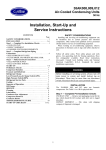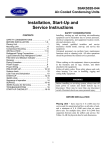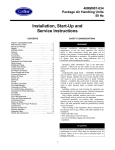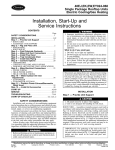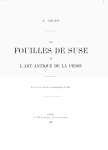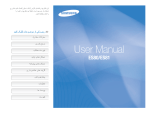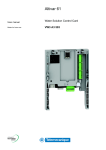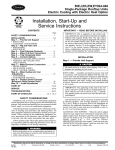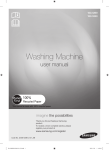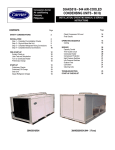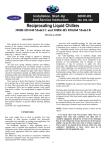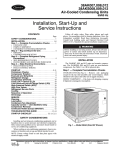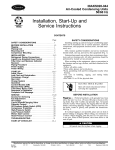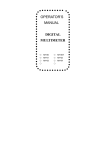Download Carrier 38AKS013-024 Unit installation
Transcript
38AKS013-024 Air-Cooled Condensing Units Installation, Start-Up and Service Instruction CONTENTS WARNING SAFETY CONSIDERATIONS . . . . . . . . . . . . . . . . . . . . 1 INSTALLATION . . . . . . . . . . . . . . . . . . . . . . . . . . . . . 1-8 Step 1 — Complete Pre-Installation Checks. . . . . . . . . . . . . . . . . . . . . . . . . . …….. . . . . . . . . . 1 Step 2 — Rig and Mount the Unit . . . . . . . . . . . . . . . 4 Step 3 — Complete Refrigerant Piping Connections . . . . . . . . . . . . . . . . . . . . . . . . . . . . . . . . . . 5 Step 4 — Install Accessories . . . . . . . . . . . .. . . . . . . 6 Step 5 — Complete Electrical Connections. . . . . . 6 PRE-START-UP . . . . . . . . . . . . . . . . . . . . . . . . . . . . . . . 7 System Check. . . . . . . . . . . . . . . . . . . . . . . . . . . . . . . . . 7 Leak Test and Dehydration . . . . . . . . . . .. . . . . . . . . . 8 Turn On Crankcase Heater . . . . . . . . . . . . . . . . . . . . 8 Preliminary Charge. . . . . . . . . . . . . . . . . . . . . . . . . . ... 8 START-UP . . . . . . . . . . . . . . . . . . . . . . . . . . . . . . . . ... 8-10 OPERATING SEQUENCE . . . . . . . . . . . . . . . . . . . . . . 8 Cooling . . . . . . . . . . . . . . . . . . . . . . . . . . . . . . . .. . . . . . . 10 Heating. . . . . . . . . . . . . . . . . . . . . . . . . . . . . . . . . . . . . . 10 SERVICE . . . . . . . . . . . . . . . . . . . . . . . . . . . . .. . . . . . 10-12 Capacity Control (38AKS Units) . . …….. . .. . . . . . . 10 Time Guard II Circuit (38AKS) . . . . . . . . . ……... . . . 10 Crankcase Heater . . . . . . . . . . . . . . . . . . . . . . . . . . . . . 10 Compressor Protection . . . . . . . . . . . . . . .. . . . . . . . . 10 Low-Pressure Switches . . . . . . . . . . . . . . . . . . . . . . . 11 High-Pressure Switches. . . . . . . . . . . . .. . . . . . . . . . .11 Outdoor Fans . . . . . . . . . . . . . . . . . . . . . . . . . . . . . . . . . 11 Lubrication. . . . . . . . . . . . . . . . . . . . . . . . . . . . . . . . . . . 11 Coil Cleaning and Maintenance . . . . . . . . . . . . . . . . 12 TROUBLESHOOTING. . . . . . . . . . . . . . . . . . . . . . . .13-14 START-UP CHECKLIST . . . . . . . . . . . ……….... . 14-15 Before installing or servicing system, always turn off main power to system and install lockout tag on disconnect. There may be more than one disconnect switch. Electrical shock can cause personal injury. INSTALLATION Step 1 — Complete Pre-Installation Checks Remove unit packaging after the unit is rigged into its final location. ( see Fig.1) INSPECT SHIPMENT — File a claim with shipping company if the shipment is damaged or incomplete. CONSIDER SYSTEM REQUIREMENTS • Consult local building codes and National Electrical Code for special installation requirements. SAFETY CONSIDERATIONS Installing, starting up, and servicing air-conditioning equipment can be hazardous due to system pressures, electrical components, and equipment location (roofs, elevated structures, etc). Only trained, qualified installers and service mechanics should install, start-up, and service this equipment. Untrained personnel can perform basic maintenance functions such as cleaning coils. All other operations should be performed by trained service personnel. When working on the equipment, observe precautions in the literature and on tags, stickers, and labels attached to the equipment. Follow all safety codes. Wear safety glasses and work when brazing. Use care in handling, rigging and setting bulky equipment. Fig. 1 Model 38AKS013 • Allow sufficient space for airflow clearance, wiring, refrigerant piping, and servicing unit. See Fig. 2 for unit dimensions and weight distribution data. • Locate the unit so that the outdoor coil (condenser) airflow is unrestricted on all sides and above. • The unit may be mounted on a level pad directly on the base channels or mounted on raised pads at support points. See Tables 1A,1B for unit operating weights. See Fig. 2 for weight distribution based on recommended support points. NOTE: If vibration isolators are required for a particular installation, use the data in Fig. 1-4 to make the proper selection 1 UNIT 38AKS 013 016 024 Standard weight lb(kg) ALUMINUM COIUL Operational Weight point lb (kg) A B C D E F Standa rd weight lb(kg) COPPER COIL Operational Weight point lb (kg) A B C D E F 779(354) 70(32) 177(80) 68(31) 100(45) 261(119) 103(47) 919(418) 99(45) 224(102) 96(44) 114(52) 268(122) 118(54) 789(359) 70(32) 180(82) 69(31) 101(46) 265(120) 104(47) 929(422) 99(45) 228(104) 96(44) 115(52) 273(124) 118(54) 929(422) 84(38) 234(106) 82(37) 108(49) 310(141) 111(50) 1040(473) 110(50) 283(129) 107(49) 116(53) 305(139) 119(54|) Fig. 2 NOTES: 1. Use 2-in. (50-mm) OD pipe or hooks in lifting holes. 2. Rig with 4 cables and spread with two D long and two A long 2*4 in. (50*100 mm) bars or equal. 3. Run the rigging cables to a central suspension point so that the angle from the horizontal is not less than 45 degrees. 2 Table 1A – physical Data – 38AKS013-024 Units – 50Hz, English UNIT 38AK 013 016 S024 NOMINAL CAPACITY (tons) OPERATING WEIGHTS (lb) Aluminum-Fin coils (standard) Copper-Fin Coils (optional) REFRIGERANT* Operating Charge, typical (lb)† Shipping Charge (lb) COMPRESSOR QTY … model Oil charge (oz) No. Cylinders Speed (rpm) Capacity Steps (%) Unloader Setting (psig) Unloader No. 1 Load unload Unloader No. 2 Load unload Crankcase Heater Watts CONDENSER FANS QTY… (Rpm) Diameter (in.) Nominal Nominal Airflow (cfm total) Watts (Total) CONDENSER COIL ROWS... Fins/in. Face Area (sq ft total) Storage Capacity (lb)** CONTROLS Pressure stat Settings (psig) high Open Close Low Open Close Oil pressure Switch Open Close FAN CYCLING CONTROLS Operating pressure (psig) No. 2 Fan, Close Open PRESSURE RELIEF Location Temperature (F) PIPING CONNECTIONS (in. ODM) Suction Liquid Hot Gas 10.6 15 20 732 825 789 929 R-22 23 3.1 900 1040 22 2.1 Copeland, Scroll 2 … ZR61KC 2 … ZR94KC 66 85 2900 2900 100, 66, 50 70 1490 2 … 19 39.2 37.3 28 5 Recip., Semi-Hermetic 1 … 06EA250 247 4 1450 90 Propeller Type – Direct Drive 2 … 900 26 ½ 9210 1750 Copper Tubes, Aluminum Fins 3 … 17 39.2 56.6 76 58 125 2 … 900 23.700 1520 3 … 17 58.4 84.4 426+7 320+20 27+3 60+5 - 255+10 160+10 1⅜ 1⅜ ⅝ ⅜ ⅝ ⅜ * Unit is factory supplied with holding charge only. † Typical operation charge with 25 ft of interconnecting piping. Operating charge is approximate for maximum system capacity. ** Storage capacity is 80% full liquid saturated temperature of 125 F. 3 1⅝ ⅝ ⅜ Table 1B – physical data – 38AKS013-024 Units – 50Hz, SI UNIT 38AK NOMINAL CAPACITY (kw) OPERATING WEIGHTS (kg) Aluminum-fin Coils (standard) Copper-Fin Coils (optional) REFRIGERANT* Operating charge, Typical (kg)† COMPRESSOR Qty … Model Oil charge (L) No. Cylinders Speed (r/s) Capacity Steps (%) Unloader Settings (kpag) Unloader No. 1 Load Unload Unloader No. 2 Load Unload Crankcase heater Watts CONDENSER FANS Qty … r/s Diameters (mm) Nominal Hp Nominal Airflow (L/S total) Watts (Total) CONDENSER COIL Rows … Fins/m Face Area (Sq m total) Storage Capacity (kg)** CONTROLS Pressure stat Settings (kpag) High Open Close Low Open Close Oil pressure Switch Open Open FAN CYCLING CONTROLS Operating pressure (kpag) No. 2 Fan, Close Open PRESSURE RELIEF Location Temperature (C) PIPING CONNECTIONS (in, ODM) Suction Liquid Hot Gas 013 37.8 016 50.2 S024 62.5 748 818 818 911 R-22 11 1106 1246 10 Copeland, Scroll 2…ZR61KC 2…ZR94KC 2 2.5 58.4 100, 66, 33 70 1490 2…748 3.64 17.0 12.7 Recip., Semi-Hermetic 1…06EA250 7.33 4 29.2 90 Propeller Type – Direct Drive 2…15 660 ½ 7400 1750 Copper Tubes, Aluminum Fins 3…670 3.64 25.7 483 ±6.9 414 ±13.8 125 11.180 1460 3…670 5.43 38.3 293+48 2206+138 186+27 413+103 - 1758+69 1103+69 1⅜ 1⅜ ⅝ ⅜ ⅝ ⅜ 1⅝ ⅝ ⅜ * Unit is factory supplied with holding charge only. † Typical operation charge with 25 ft of interconnecting piping. Operating charge is approximate for maximum system capacity. ** Storage capacity is 80% full liquid saturated temperature of 125 F. Step 2 — Rig and Mount the Unit central suspension point so that the angle from the horizontal is not less than 45 degrees. Raise and set the unit down carefully. If it is necessary to roll the unit into position, mount the unit on longitudinal rails, using a minimum of 3 rollers. Apply force to the rails, not the unit. If the unit is to be skidded into position, place it on a large pad and drag it by the pad. Do not apply any force to the unit. Raise from above to lift the unit from the rails or pad when unit is in its final position. After the unit is in position, remove all shipping materials CAUTION Be sure unit panels are securely in place prior to rigging. RIGGING — These units are designed for overhead rigging. Refer to the rigging label for preferred rigging method. Spreader bars are not required if top crating is left on the unit. All panels must be in place when rigging. As further protection for coil faces, plywood sheets may be placed against the sides of the unit, behind cables. Run cables to a 4 and top crating. COMPRESSOR MOUNTING — As shipped, the compressor is held tightly in place by self-locking bolts. Before starting the unit, loosen the self-locking bolts until the snubber washer can be moved sideways with finger pressure. Do not remove the shipping bolts. See Fig. 3. Step 3 — Complete Connections Refrigerant Table 2 – Liquid Line Data LIQUID LINE Piping IMPORTANT: A refrigerant receiver is not provided with the unit. Do not install a receiver. SIZE REFRIGERANT LINES — Consider the length of piping required between the outdoor unit and indoor unit (evaporator), the amount of liquid lift, and compressor oil return. See Tables 2-4. Refer to the indoor unit installation instructions for additional information. Condensing units with multiple-step unloading may require double suction risers to assure proper oil return at minimum load operating condition. See Tables 2-4and Fig. 4. Analyze the evaporator coil’s surface reduction to ensure sufficient refrigerant velocity to return oil to the compressor. Liquid line solenoid valves may be used in certain situations to accomplish this. Hot gas bypass, if used, should be introduced before the evaporator. Note that refrigerant suction piping should be insulated. UNIT 38 AKS MAXIMUM ALLOWABLE LIQUID LIFT ft (m) 013 016 024 67 (20.4) 82 (25.0) 87 (26.5) Maximum Allowable pressure Drop Psig (kpa) Maximum Allowable Temp Loss. F (C) Filter Drier and sight Glass Flare Conn.* in. 7 (48.3) 2 (1.1) 5/8 *Inlet and outlet. NOTE: Data shown is for units operating at 45 F (7.2 C) saturated suction temperatures and 95 F (35 C) entering air temperature. Table 3 — Refrigerant Piping Sizes COND UNIT 38AkS 013 016 024 LENGTH OF INTERCONNECTIONH PIPING, FT (M) 0-15 15-25 25-50 50-75 75-100* (0-4.5) (4.5-7.5) (.5-15) (15-23) (23-30) Line Size (in. OD) L S L S L S L S L S ½ ½ ½ 1⅜ 1⅜ 1⅜ ½ ½ ⅝ 1⅜ 1⅜ 1⅝ ½ ⅝ ⅝ 1⅜ 1⅜ 1⅝ ⅝ ⅝ ⅝ 1⅝† 1⅝ 2⅛ ⅝ ¾ ¾ 1⅝† 1⅝ 2⅛ LEGEND L — Liquid S — Suction *Field-supplied suction accumulator required for pipe length 75 100 ft (23-30 m). †Requires a double suction riser if 2 unloaders are used and the evaporator is below the condensing unit. NOTES: 1. Pipe sizes are based on a 2 F (1.1 C) saturated temperature loss for liquid lines and a 1.5 F (0.8 C) saturated temperature loss for suction lines. 2. Pipe sizes are based on an equivalent length equal to the maximum length of interconnecting piping plus 50% for fittings. A more accurate estimate may result in smaller sizes. 3. For applications with refrigerant line lengths greater than 100 ft, contact Sarma Afarin Aftersales Dept. Fig. 3 – Compressor Mounting Table 4 — Refrigerant Piping Sizes, Double Suction Risers 38AKS013 - 50 Hz Units COND UNIT 38AK 013 Fig. 4 – Suction Line Piping LENGTH OF INTERCONNECTING PIPING FT (M) 50-75 75-100 (15-23) (23-30) Line Size (in. OD) A B C A B C 1⅛ 1⅜ 1⅝ 1⅛ 1⅜ 1⅝ NOTES: 1. See Fig. 4 for “A,” “B,” and “C” dimensions. 2. Double suction risers are not required for unit size 016 or 024. INSTALL FILTER DRIER(S) AND MOISTURE INDICATOR(S) —For every unit should be installed in site filter drier(s) and a liquid moisture indicator(s) (sight glass). In some applications, depending on space and convenience requirements, it may be desirable to install 2 filter driers and sight glasses. One filter drier and sight glass may be installed at A locations in Fig. 5; or, 2 filter driers and sight glasses may be installed at B locations. 5 Select the filter drier for maximum unit capacity and minimum pressure drop. Complete the refrigerant piping from the indoor unit to the outdoor unit before opening the liquid and suction lines at the outdoor unit. INSTALL LIQUID LINE SOLENOID VALVE — It is recommended that a solenoid valve be placed in the main liquid line (see Fig. 5) between the condensing unit and the fan coil (A liquid line solenoid valve is required when the liquid line length exceeds 75 ft [23 m] or when the condensing unit is connected to a chiller barrel in a built-up chiller system.) This valve prevents refrigerant migration (which causes oil dilution) to the compressor during the off cycle, at low outdoor ambient temperatures. Wire the solenoid in parallel with the compressor contactor coil. 1. Open service valves: a. Discharge service valve on compressor. b. Suction service valve on compressor. c. Liquid line valve. 2. Remove 1/4-in. flare cap from liquid valve Schrader port. 3. Attach refrigerant recovery device and recover holding charge. 4. Remove runaround loop. 5. Install a field-supplied liquid moisture indicator in the piping immediately leaving outdoor unit. 6. install field-supplied thermostatic expansion Valve (TXVs) in air handler. If 2 TXVs are installed and two-step cooling is desired, install a field-supplied liquid line solenoid valve ahead of the upper TXV (see Fig. 5). INSTALL LIQUID LINE SOLENOID VALVE (Optional) - CAPACITY CONTROL — If 2-step cooling is desired, place a solenoid valve in the location shown in Fig. 5. MAKE PIPING CONNECTIONS — Do not remove the runaround loop from the suction and liquid line stubs in the compressor compartment until the piping connections are ready to be made. Pass nitrogen or other inert gas through the piping while brazing to prevent the formation of copper oxide. Fig. 5 – Location of Sight Glass (es) and Filter Driers WARNING Recover holding charge prior to removal of runaround piping loop. TXV – Thermostat Expansion Valve PROVIDE SAFETY RELIEF — A fusible plug is located n the compressor crankcase or in the liquid line (Fig. 6). Do not cap this plug. If local code requires additional safety devices, install them as directed. Step 4 — Install Accessories — Field install accessories before proceeding with wiring. Refer to the instructions shipped with the accessory. Step 5 — Complete Electrical Connections POWER WIRING — The unit is factory wired for the voltage shown on its nameplate. Provide an adequate fused disconnect switch within sight from unit and readily accessible from unit, but out of the reach of children. Lock the switch open (off) to prevent power from being turned on while the unit is being serviced. A disconnect switch, fuses, and field wiring must comply with national and local code requirements. Route power wires through the opening in unit’s end panel to the connection in the unit’s control box, as shown on unit label diagram and in Fig. 7. The unit must be grounded. Affix the crankcase heater warning sticker to the unit disconnect switch. CONTROL CIRCUIT WIRING —See Fig. 8 and the unit’s label diagram for field-supplied wiring details. Route control wires through the opening in unit’s end panel to the connection in the unit’s control box. Note: 38AKS024 has a fusible plug in the liquid line. Fig. 6 – Location of Fusible Plug LEGEND EQUIP GND — Equipment Ground NEC — National Electrical Code _______ — Factory Wiring _ _ _ _ _ — Field Wiring 6 Fig.7 – Main Power Supply Wiring R — Relay _______ — Factory Wiring _ _ _ _ _ — Field Wiring NOTES: 1. Combination LLSV plus IFC va should not exceed 30 va. 2. Do not exceed 5 va (24 vac) per coil. LEGEND C — Compressor Contactor HD — Heating Device IFC — Indoor Fan Contactor LLSV1 — Liquid Line solenoid Valve 1 – Refrigerant Migration Control LLSV2 — Liquid Line solenoid Valve 1 – Capacity Control Fig. 8 – Typical Remote Thermostat wiring. Table 5- Electrical Data – 38 AKS013-024 50 HZ UNIT 38AKS 013 016 024 NOMINAL VOLTAGE (3 ph, 50Hz) 230 400 230 400 346 230 400 VOLTAGE RANGE* COMPRESSOR Min Max RLA LRA 198 342 198 342 311 198 342 264 457 264 457 380 254 440 35.7 22.1 47.9 29.3 33.3 67.9 34.6 143 83 200 115 115 207 173 FAN MPTORS (Qty 2 FLA (ea) 1 2 3.5 2.9 3.5 2.9 3.5 2.9 3.5 2.9 3.5 2.9 3.5 2.9 3.5 2.9 POWER SUPPLY MCA MOCP† 51.0 34.0 66.9 43.0 50.0 88.1 49.3 80 50 100 70 80 150 80 information, and operation at initial start-up. LEGEND FLA — Full Load Amps LRA — Locked Rotor Amps MCA — Minimum Circuit Amps MOCP — Maximum Over current Protection RLA — Rated Load Amps CAUTION Do not attempt to start the condensing unit, even momentarily, until the following steps have been completed. Compressor damage may result. *Units are suitable for use on electrical systems where voltage supplied to the *unit terminals is not below or above the listed limits. NOTES: 1. The MCA and MOCP values are calculated in accordance with the NEC, Article 440. 2. Motor RLA and LRA values are established in accordance with Underwriters’ Laboratories (UL), Standard 1995. System Check 1. Check all air handler(s) and other equipment auxiliary components. Consult the manufacturer’s instructions regarding any other equipment connected to the condensing unit. If the unit has field-installed accessories, be sure all are properly installed and correctly wired. If used, the airflow switch must be properly installed. 2. Backseat (open) the compressor suction and discharge valves. Now close the valves one turn to allow refrigerant pressure to reach test gages. 3. Open the liquid line service valve. PRE-START-UP IMPORTANT: Before beginning Pre-Start-Up or Start-Up, review Start-Up Checklist at the back of this book. The Checklist assures proper start-up of a unit and provides a record of unit condition, application requirements, system 7 4. Check tightness of all electrical connections. 5. For 38AKS unit, the compressor oil level should be visible in the sight glass. Adjust the oil level as required. Refer to the Start-Up, Preliminary Oil Charge section. Do not remove any oil unless the crankcase heater has been energized for at least 24 hours. 6. Be sure the unit is properly leak checked, dehydrated, and charged. See Preliminary Charge, this page. 7. The electrical power source must agree with the unit’s nameplate rating. 8. The crankcase heater must be firmly locked into the compressor crankcase. Be sure the crankcase is warm (heater must be on for 24 hours before starting compressor). 9. Be sure the compressor floats freely on the mounting springs and that the snubber washers can be moved with finger pressure. Leak Test and Dehydration — Leak test the entire refrigerant system using soap bubbles and/or an electronic leak detector. Evacuate and dehydrate the entire refrigerant system to 500 microns using a two-stage vacuum pump as described in GTAC II, Module 4, System Dehydration. Turn On Crankcase Heater — Turn on the crankcase heater for 24 hours before starting the unit to be sure all the refrigerant is out of the oil. To energize the crankcase heater, proceed as follows: 1. Set the space thermostat set point above the space temperature so there is no demand for cooling. 2. Close the fields disconnect. 3. Turn the fan circuit breaker on. Leave the compressor circuit breakers off. The crankcase heater is now energized. 5. Check that the compressor crankcase heater has been on at least 24 hours. 6. Note that the compressor oil level is visible in the sight glass. 7. Recheck for leaks using the same procedure as previously outlined in Pre-Start-Up section, Leak Test and Dehydration. 8. If any leaks are detected, evacuate and dehydrate as previously outlined in Pre-Start-Up section, Leak Test and Dehydration. 9. All internal wiring connections must be tight, and all barriers and covers must be in place. PRELIMINARY OIL CHARGE — The compressor is factory charged with oil (see Tables 1A-1B). When the oil is checked at start-up, it may be necessary to add or remove oil to bring it to the proper level. One recommended oil level adjustment method follows: Add Oil — Close the suction service valve and pump down crankcase to 2 psig (14 kPag). (The low-pressure switch must be jumpered.) Wait a few minutes and repeat until the pressure remains steady at 2 psig (14 kPag). Remove the oil fill plug above the oil level sight glass, add oil through the plug hole, and replace the plug. Run the compressor for 20 minutes and check the oil level. See Fig. 12. NOTE: Use only Carrier approved compressor oil. Approved sources are: Petroleum Specialties Inc. . . . . . . . . . . . . . . . . . Cryol 150A Texaco, Inc.. . . . . . . . . . . . . . . . . . . . . . . . . . Capella WF-32 Witco Chemical Co.. . . . . . . . . . . . . . . . . . . . . . Suniso 3GS Do not use oil that has been drained out, or exposed to atmosphere. Remove Oil — Pump down the compressor to 2 psig (14 kPag). Loosen the 1/4-in. (6.4 mm) pipe plug at the compressor base and allow the oil to seep out past the threads of the plug. NOTE: The crankcase will be slightly pressurized. Do not remove the plug, or the entire oil charge will be lost. Small amounts of oil can be removed through the oil pump discharge connection, while the compressor is running. START UNIT — The field disconnect is closed, the fan circuit breaker is closed, and the space thermostat is set above ambient so that there is no demand for cooling. Only the crankcase heater will be energized. Close the compressor circuit breaker and then reset the space thermostat below ambient so that a call for cooling is ensured. NOTE: Do not use a circuit breaker to start and stop the compressor except in an emergency After starting, there is a delay of at least 3 seconds before compressor starts. Preliminary Charge — Before starting the unit, charge liquid refrigerant into the high side of the system through the liquid service valve. The amount of refrigerant added must beat least 80% of the operating charge listed in the Physical Data table (Tables 1A , 1B). Allow high and low side pressures to equalize before starting compressor. If pressures do not equalize readily, charge vapor on low side of system to assure charge in the evaporator. Refer to GTAC II, Module 5, Charging, Recover, Recycling, and Reclamation for liquid charging procedures. CAUTION Prior to starting compressor, a preliminary charge of refrigerant must be added to avoid possible compressor damage. START-UP CAUTION The compressor crankcase heater must be on for 24 hours before start-up. After the heater has been on for 24 hours, the unit can be started. If no time elapsed since the preliminary charge step was completed, it is unnecessary to wait the 24-hour period. PRELIMINARY CHECKS 1. Ensure that the compressor service valves are back seated. 2. Verify that each compressor floats freely on its mounting springs. 3. Check that electric power supply agrees with the unit’s nameplate data. 4. Verify that the compressor crankcase heater is securely in place. Never charge liquid into the low-pressure side of system. Do not overcharge. During charging or removal of refrigerant, be sure indoor-fan system is operating. ADJUST REFRIGERANT CHARGE — The unit must be charged in Cooling mode only. Refer to Cooling Charging Charts, Fig. 9-11 for maximum charge level. Vary refrigerant until the conditions of the chart are met. Note that the charging charts are different from the type normally used. Charts are based on charging the units to the correct sub cooling for the various operating conditions. Accurate pressure gage and temperature sensing devices are required. Connect the pressure gage to the service port on the liquid 8 line service valve. Mount the temperature sensing device on the liquid line, close to the liquid line service valve, and insulate it so that outdoor ambient temperature does not affect the reading. Indoor airflow must be within the unit’s normal operating range. Operate the unit for a minimum of 15 minutes. Ensure that pressure and temperature readings have stabilized. Plot liquid pressure and temperature on chart and add or reduce the refrigerant charge to meet the curve. Adjust the charge to conform with the charging chart, using the liquid pressure and temperature to read the chart. If the sight glass is cloudy, check the refrigerant charge again. Ensure that all fans are operating. Also ensure that the maximum allowable liquid lift has not been exceeded. If refrigerant is charged per the chart and if the sight glass is still cloudy, check for a plugged filter drier or a partially closed solenoid valve. Replace or repair, as needed Fig. 9 – 38AKS013 Charging chart Fig. 10 – 38AKS016 Charging Chart 9 Fig. 11 – 38AKS024 Charging Chart timer activates the compressor and fan motor no. 1 contactors. When the liquid pressure builds to approximately 257 psig, fan motor no. 2 is energized. When there is demand for additional cooling capacity, the second stage of the cooling thermostat closes, energizing a field-supplied liquid line solenoid (LLS) valve, which opens. This increases the suction pressure, causing the compressor to operate at higher capacity (compressor loads). When the fan switch is set at AUTO, the indoor-air fan cycles with the compressor. When the switch is set at CONT, the indoor-air fan runs continuously. At shutdown, the Time Guard II timer prevents the compressor from restarting for approximately 5 minutes. In addition, an LLS valve wired in parallel with the compressor contactor coil shuts off the liquid line to prevent refrigerant migration back to the compressor during the off cycle. CHECK COMPRESSOR OIL LEVEL — After adjusting the refrigerant charge, allow the compressor to run fully loaded for 20 minutes. The running oil level should be within view of the crankcase sight glass. Stop the compressor at the field power supply disconnect and check the crankcase oil level. Add oil only if necessary to bring the oil into view in the sight glass. If oil is added, run the compressor for an additional 10 minutes, then stop and check the oil level. If the level remains low, check the piping system for proper design for oil return; also, check the system for leaks. If the initial check shows too much oil (too high in the sight glass) remove oil to proper level. See Preliminary Oil Charge, this page, for proper procedure for adding and removing oil. See Fig. 12. When the above checks are complete, repeat the procedure with the unit operating at minimum load conditions. Unload the compressor by turning the control set point adjustment nut counterclockwise until the adjustment nut stops. The unloader is now at 0 psig (0 kPa) set point. If electric actuated unsolders are installed, energize the solenoid to unload the compressor. Return the unloader to its original setting after all checks are complete. FINAL CHECKS — Ensure that all safety controls are operating, control panel covers are on, and the service panels are in place. Heating — The heating thermostat (TH) energizes a field supplied relay, which operates heating controls and energizes the indoor unit relay. When the fan switch is set at AUTO, the indoor unit fan cycles with the heating control. The indoor unit fan runs continuously when the fan switch is set at ON. Causes of complete unit shutdown are: interruption of supplied power, open compressor internal protector (IP), open control circuit breaker, or an open high-pressure or low-pressure safety switch. Capacity 38AKS024 38AKS013, 016 (06E Compressor) (06D Compressor) SERVICE Control— A suction pressure-actuated unloader controls 2 cylinders and provides capacity control. Unsolders are factory set (see Tables 1A-1B), but can be field adjusted as described in the 2 following sections. CONTROL SET POINT (cylinder load point) is adjustable from 0 to 85 psig (586 kPa). To adjust, turn the control set point adjustment nut clockwise to its bottom stop. In this position, set point is 85 psig (586 kPa). Next, turn the adjustment counterclockwise to the desired control set point. Every full turn counterclockwise decreases the set point by 7.5 psig (51.7 kPa). PRESSURE DIFFERENTIAL (difference between cylinder load and unload points) is adjustable from 6 to 22 psig (41.4 to 152 kPag). To adjust, turn the pressure differential adjustment screw counterclockwise to its back stop position. In this position, the differential is 6 psig (41.4 kPag). Next, Fig. 12 – Operation Oil Levels Cooling —When the first stage of the cooling thermostat closes, the timer starts. After approximately 3 seconds, the 10 Outdoor Fans — Each fan is supported by a formed wire turn the adjustment clockwise to the desired pressure differential setting. Every full turn clockwise increases the differential by 1.5 psig (10.3 kPag). mount bolted to the fan deck and covered with a wire guard. Fan motors have permanently lubricated bearings. NOTE: On 38AKS units, the exposed end of the motor shaft is covered with a rubber boot. In case a fan motor must be repaired or replaced, be sure the rubber boot is put back on when the fan is reinstalled and be sure the fan guard is in place before starting the unit. Figure 20 shows the mounted fan’s proper position. Time Guard II Circuit — This circuit prevents short-cycling by providing a delay of approximately 5 minutes before restarting compressor after shutdown from safety device action. On start-up, the Time Guard II timer causes a delay of approximately 3 seconds after thermostat closes. On compressor shutdown, the timer recycles for approximately 5 minutes. During this time, the compressor cannot restart. Refer to Fig. 19 and to label diagram on unit. Crankcase Heater — The heater prevents refrigerant migration and compressor oil dilution during shutdown whenever compressor is not operating. The heater is wired to cycle with the compressor; the heater is off when compressor is running, and on when compressor is off. Both compressor service valves must be closed whenever the crankcase heater is deenergized for more than 6 hours. The crankcase heater will operate as long as the control circuit is energized. Lubrication FAN MOTORS have sealed bearings. No provisions are made for lubrication. COMPRESSOR has its own oil supply. Loss of oil due to a leak in the system should be the only reason for adding oil after the system has been in operation. Coil Cleaning and Maintenance — This section describes the cleaning and maintenance of standard coilsand E-Coated coils. Routine cleaning of coil surfaces is essential to minimize contamination build-up and remove harmful residue. Inspect coils monthly and clean them as required. Compressor Protection CIRCUIT BREAKER— The calibrated trip manual reset, ambient compensated, magnetic breaker protects against motor overload and locked rotor conditions. COMPRESSOR OVERTEMPERATURE PROTECTION (IP) — A thermostat installed on the compressor motor winding reacts to excessively high winding temperatures and shuts off the compressor. TIME GUARD II CONTROL— Control prevents compressor from short cycling. See Operating Sequence. CRANKCASE HEATER — The heater minimizes absorption of liquid refrigerant by oil in the crankcase during brief or extended shutdown periods. The control circuit is maintained if the compressor fan motor circuit breakers are turned off. The main disconnect must be on to energize the crankcase heater. Fig. 14 – Outdoor Fan – 38AKS Units CLEANING STANDARD COILS — Standard coils can be cleaned with a vacuum cleaner, washed out with low velocity water, blown out with low-pressure compressed air, or brushed (do not use wire brush). Fan motors are dripproof but not waterproof. Do NOT use acid cleaners. Clean the outdoor coil annually or as required by location or outdoor air conditions. Inspect the coil monthly, and clean as required. Fins are not continuous through coil sections; dirt and debris may pass through the first section, become trapped between the second and third rows of fins and restrict outdoor airflow. Use a flashlight to determine if dirt or debris has collected between coil sections. Clean the coil as follows: 1. Turn off unit power. 2. Remove screws holding rear corner posts and top cover in place. Pivot top cover up 12 to 18 in. (305 to 457 mm) and support with a rigid support. See Fig. 15. 3. Remove clips securing tube sheets together at the return bend end of the coil. Carefully spread the ends of the coil rows apart by moving the outer sections. See Fig. 16. 4. Using a water hose, or other suitable equipment, flush down between the sections of coil to remove dirt and debris. 5. Clean the remaining surfaces in the normal manner. IMPORTANT: Never open any switch or disconnect that energizes the crankcase heater unless unit is being serviced or is to be shut down for a prolonged period. After a prolonged shutdown on a service job, energize the crankcase heater for 24 hours before starting the compressor. Fig. 13 – Timer Sequence Chart Low-Pressure Switches —. The 38AKS low-pressure switches are mounted on the compressor. Switches are all fixed, non-adjustable type. High-Pressure Switches The 38AKS high-pressure switches are mounted on the compressor. The switches are all fixed, non-adjustable type. 11 to avoid damaging the fin edges. Monthly cleaning is recommended. Routine Cleaning of E-Coated Coil Surfaces — Monthly cleaning with Environmentally Sound Coil Cleaner is essential to extend the life of coils. It is recommended that all coils including standard aluminum, pre-coated, copper/copper, or E-coated coils be cleaned with the Environmentally Sound Coil Cleaner as described below. Coil cleaning should be part of the unit’s regularly scheduled maintenance procedures to ensure long coil life. Failure to clean the coils may result in reduced durability in the environment. Environmentally Sound Coil Cleaner is non-bacterial, biodegradable and will not harm the coil or surrounding components such as electrical wiring, painted metal surfaces or insulation. Use of non-recommended coil cleaners is strongly discouraged since coil and unit durability could be affected. The following field-supplied equipment is required for coil cleaning: • 21/2 gallon garden sprayer • Water rinse with low velocity spray nozzle Environmentally Sound Coil Cleaner Application Instructions — perform the following procedure to clean the coil. NOTE: Wear proper eye protection such as safety glasses during mixing and application. 1. Remove all surface debris and dirt from the coil with a vacuum cleaner. 2. Thoroughly wet finned surfaced with clean water and a low velocity garden hose, being careful not to bend fins. 3. Mix Environmentally Sound Coil Cleaner is a 2 1/2 gallon garden sprayer according to the instructions included with the Environmentally Sound Coil Cleaner. The optimum solution temperature is 100 F. Fig. 15 – Pivot and Support Top Cover Fig. 16 – Coil Cleaning (Typical) 6. Reposition outer coil sections. 7. Reinstall clips which secure tube sheets. 8. Replace top cover and rear corner posts. CLEANING AND MAINTAINING COILS — routine cleaning of condenser coil surfaces is essential to maintain proper unit operation. Eliminate contamination and remove harmful residue to greatly increase the life of the coil and extend unit life. The following maintenance and cleaning procedures are recommended as part of the routine maintenance activities to extend coil life. Remove Surface Loaded Fibers — Remove debris such as dirt and fibers on the surface of the coil with a vacuum cleaner. If a vacuum cleaner is not available, use a soft brush. Apply the cleaning tool in the direction of the fins. Coil surfaces can be easily damaged (fin edges bent over) if the tool is applied across the fins. NOTE: Using water stream, such as a garden hose, against a surface loaded coil will drive the fibers and dirt into the coil. This will make cleaning efforts more difficult. Surface debris must be completely removed prior to using a low velocity clean water rinse. Periodic Clean Water Rinse — A periodic clean water rinse is very beneficial for coils that are applied in coastal or industrial environments. However, it is very important that the water rinse is made with very low velocity water stream CAUTION DO NOT USE water in excess of 130 F. Enzymes in coil cleaner will be destroyed and coil cleaner will not be effective. 4. Thoroughly apply Environmentally Sound Coil Cleaner solution to all coil surfaces including finned area, tube sheets, and coil headers. Hold garden sprayer nozzle close to finned areas and apply cleaner with a vertical, up-and-down motion. Avoid spraying in horizontal pattern to minimize potential for fin damage. Ensure cleaner thoroughly penetrates deep into finned areas. Interior and exterior finned areas must be thoroughly cleaned. 5. Allow finned surfaces to remain wet with cleaning solution for 10 minutes. Ensure surfaces are not allowed to dry before rinsing. Reapply cleaner as needed to ensure 10 minute saturation is achieved. 6. Thoroughly rinse all surfaces with low velocity clean water using downward rinsing motion of water spray nozzle. Protect fins from damage from the spray nozzle. 12 CAUTION Do not use bleach, harsh chemicals, or acid cleaners on outdoor or indoor coils of any kind. These types of cleaners are difficult to rinse, and they promote rapid corrosion of the fin collar-copper tube connection. Only use the Environmentally Sound Coil Cleaner. Never use high pressure air or liquids to clean coils. High pressures damage coils and increase the airside pressure drop. To promote unit integrity, follow cleaning and maintenance procedures in this document. TROUBLESHOOTING PROBLEM COMPRESSOR DOES NOT RUN Contractor Open 1. Power off. 2. Fuses blown in field power circuit. 3. No control power,. 4. Thermostat circuit open. 5. Time Guard ll device not operating. 6. Compressor circuit breaker tripped. 7. Safety device lockout circuit active. 8. Low-pressure switch open. 9. High-pressure switch open. 10. Compressor over temperature switches open. 11. Loose electrical connections. 12. Compressor stuck. Contactor Closed 1. Compressor leads loose. 2. Motor winding open. 3. Single phasing. COMPRESSOR STOPS ON HIGH-PRESSURE SWITGH Outdoor Fan On. 1. High-pressure switch faculty. 2. reversed fan rotation. 3. Airflow restricted. 4. Air recalculating. 5. Noncondensables in system. 6. Refrigerant overcharge. 7. Line voltage incorrect. 8. Refrigerant system restrictions. Outdoor Fan Off 1. Fan slips on shaft. 2. Motor not running. 3. Motor bearings stuck. 4. Motor Overload Open. 5. Motor burned out. COMPRESSOR CYCLES ON LOW-PRESSURE SWITCH Indoor-Air Fan Running 1. Compressor suction service valve partially closed. 2. Liquid line solenoid valve(s) fails to open. 3. Filter drier plugged. 4. Expansion valve power head defective. SOLLUTION 1. Restore power. 2. After finding caused and correcting, replace with correct size fuse. 3. Check control circuit breaker; reset if tripped or replace if defective. 4. Check thermostat setting. 5. Check Time Guard ll device. 6. Check for excessive compressor current draw. Reset breaker; Replace if defective. 7. Reset lockout circuit at thermostat or circuit breaker. 8. Check for refrigerant undercharge, obstruction of indoor airflow, or Whether compressor suction shutoff valve is fully open. Make sure Liquid line solenoid valve(s) is open. 9. check for refrigerant overcharge, obstruction of outdoor airflow, air in System, or whether compressor discharge valve if fully open. Be Sure outdoor fans are operating correctly. 10. check for open condition. Allow for reset. Replace if defective. 11. Tighten all connections. 12. See compressor service literature. 1. Check connections. 2. See compressor service literature. 3. Check for blown fuse. Check for loose connection at compressor Terminal. 1. Replace switch. 2. Confirm rotation, correct if necessary. 3. Remove obstruction. 4. Clear airflow area. 5. Recover refrigerant and recharge as required. 6. Recover refrigerant as required. 7. Consult power company. 8. Check or replace filter drier, expansion valve, etc. Check that compressor discharge service valve is fully open. 1. Tighten fan hub setscrews. 2. Check power and capacitor. 3. Replace bearings. 4. Check overloads rating. Check for fan blade obstruction. 5. Replace motor. 1. Open valve fully. 2. Check liquid line solenoid valve(s) for proper operation. Replace if Necessary. 3. Replace filter drier. 4. Replace power head. 13 5. Low refrigerant charge. COMPRESSOR CUCLES ON LOW-PRESSURE SWITCH (cont) Airflow Restricted 1. Coil iced up. 2. Coil dirty. 3. Air filters dirty. 4. Dampers closed. Indoor-Air Fan Stopped 1. Electrical connections loose. 2. Fan relay defective. 3. Motor overload open. 4. Motor defective. 5. Fan belt broken or slipping. COMPRESSOR RUNNING BUT COOLING INSUFFICENT Suction Pressure Low 1. Refrigerant charge low. 2. Head pressure low. 3. Air filters dirty. 4. Expansion valve power head defective. 5. Indoor coil partially iced. 6. Indoor airflow restricted. Suction Pressure High 1. Unloaders not functioning. 2. Compressor valve defective. 3. heat load excessive. UNIT OPERATES TOOL LONG OR CONTINUOUSLY 1. Low refrigerant charge. 2. Control contacts fused. 3. Air in system. 4. Partially plugged expansion valve or filter drier. SYSTEM IS NOISY 1. Piping vibration. 2. Compressor noisy. COMPRESSOR LOSES OIL 1. Leak in system. 2. crankcase heaters not energized during shutdown. 3. Important interconnecting piping design. FROSTED SUCTION LINE Expansion valve admitting excess refrigerant. HOT LIQUID LINE 1. Shortage of refrigerant due to leak. 2. Expansion valve opens too wide. FROSTED LIQUID LINE 1. Restricted filter drier. 2. Liquid line Solenoid valve partially closed. COMPRESSOR WILL NOT UNLOAD 1. Defective unloader. 2. Defective capacity control solenoid valve (if used) 3. Miswired capacity control liquid line solenoid (if used) 4. Weak, broken, or wrong valve body spring. COMPRESSOR WIL NOT LOAD 1. Miswired capacity control liquid line solenoid (if used) 2. Defective capacity control solenoid valve (if used) 3. Plugged strainer (high side) 4. Stuck or damaged unloader piston or piston ring(s). 5. Add charge. Check low-pressure switch setting. 1. Check refrigerant charge. 2. Clean coil fins. 3. Clean or replace filters. 4. Check damper operation and position. 1. Tighten all connections. 2. Replace relay. 3. Power supply. 4. Replace motor. 5. Replace or tighten belt. 1. Add refrigerant. 2. Check refrigerant charge. Check outdoor-air fan thermostat settings. 3. Clean or replace filters. 4. Replace power head. 5. Check low-pressure setting. 6. Remove obstruction. 1. Check unloader adjustment. Check unloader setting. 2. See compressor service literature. 3. Check for open doors or windows in vicinity of fan coil. 1. Add refrigerant. 2. Replace control. 3. Purge and evacuate system. 4. Clean or replace. 1. Support piping as required. 2. Check valve plates for valve noise. Replace compressor if bearings Are worn. 1. Repair leak. 2. Check Wiring and relays. Check heater and replace if defective. 3. Check piping for oil return. Replace if necessary. Adjust expansion valve. 1. Repair leak and recharge. 2. Adjust expansion valve. 1. Remove restriction or replace. 2. Replace valve. 1. Replace unloader. 2. Replace valve. 3. Rewire correctly. 4. Replace spring. 1. Rewire correctly. 2. Replace valve. 3. Clean or replace strainer. 4. Clean or replace the necessary parts. START-UP CHECKLIST I. PRELIMINARY INFORMATION OUTDOOR: MODEL NO. SERIAL NO. INDOOR: AIR HANDLER MANUFACTURER MODEL NO. SERIAL NO. ADDITIONAL ACCESSORIES II. PRE-START-UP OUTDOOR UNIT IS THERE ANY SHIPPING DAMAGE? (Y/N) IF SO, WHERE: WILL THIS DAMAGE PREVENT UNIT START-UP? (Y/N) 14 CHECK POWER SUPPLY. DOES IT AGREE WITH UNIT? (Y/N) HAS THE GROUND WIRE BEEN CONNECTED? (Y/N) HAS THE CIRCUIT PROTECTION BEEN SIZED AND INSTALLED PROPERLY? (Y/N) ARE THE POWER WIRES TO THE UNIT SIZED AND INSTALLED PROPERLY? (Y/N) HAVE COMPRESSOR HOLDDOWN BOLTS BEEN LOOSENED (Snubber washers are snug, but not tight)?(Y/N) CONTROLS ARE THERMOSTAT AND INDOOR FAN CONTROL WIRING CONNECTIONS MADE AND CHECKED?(Y/N) ARE ALL WIRING TERMINALS (including main power supply) TIGHT? (Y/N) HAS CRANKCASE HEATER BEEN ENERGIZED FOR 24 HOURS? (Y/N) INDOOR UNIT HAS WATER BEEN PLACED IN DRAIN PAN TO CONFIRM PROPER DRAINAGE? (Y/N) ARE PROPER AIR FILTERS IN PLACE? (Y/N) HAVE FAN AND MOTOR PULLEYS BEEN CHECKED FOR PROPER ALIGNMENT? (Y/N) DO THE FAN BELTS HAVE PROPER TENSION? (Y/N) HAS CORRECT FAN ROTATION BEEN CONFIRMED? (Y/N) PIPING ARE LIQUID LINE SOLENOID VALVES LOCATED AT THE INDOOR COILS AS REQUIRED? (Y/N) HAVE LEAK CHECKS BEEN MADE AT COMPRESSOR, OUTDOOR AND INDOOR COILS, TXVs (Thermostatic Expansion Valves), SOLENOID VALVES, FILTER DRIERS, AND FUSIBLE PLUGS WITH A LEAK DETECTOR? (Y/N) LOCATE, REPAIR, AND REPORT ANY LEAKS. HAVE ALL COMPRESSOR SERVICE VALVES BEEN FULLY OPENED (BACKSEATED)? (Y/N) HAVE LIQUID LINE SERVICE VALVES BEEN OPENED? (Y/N) IS THE OIL LEVEL IN EACH COMPRESSOR CRANKCASE VISIBLE IN THE COMPRESSOR SIGHT GLASSES?(Y/N) CHECK VOLTAGE IMBALANCE LINE-TO-LINE VOLTS: AB V AC V BC V (AB + AC + BC)/3 = AVERAGE VOLTAGE = V MAXIMUM DEVIATION FROM AVERAGE VOLTAGE = V VOLTAGE IMBALANCE = 100 X (MAX DEVIATION)/(AVERAGE VOLTAGE) = IF OVER 2% VOLTAGE IMBALANCE, DO NOT ATTEMPT TO START SYSTEM! CALL LOCAL POWER COMPANY FOR ASSISTANCE. III. START-UP CHECK INDOOR UNIT FAN SPEED AND RECORD. CHECK OUTDOOR UNIT FAN SPEED AND RECORD. AFTER AT LEAST 10 MINUTES RUNNING TIME, RECORD THE FOLLOWING MEASUREMENTS: OIL PRESSURE SUCTION PRESSURE SUCTION LINE TEMP DISCHARGE PRESSURE DISCHARGE LINE TEMP ENTERING OUTDOOR UNIT AIR TEMP LEAVING OUTDOOR UNIT AIR TEMP 15 INDOOR UNIT ENTERING-AIR DB (dry bulb) TEMP INDOOR UNIT ENTERING-AIR WB (wet bulb) TEMP INDOOR UNIT LEAVING-AIR DB TEMP INDOOR UNIT LEAVING-AIR WB TEMP COMPRESSOR AMPS (L1/L2/L3) / / CHECK THE COMPRESSOR OIL LEVEL SIGHT GLASSES; ARE THE SIGHT GLASSES SHOWING OIL LEVEL IN VIEW (38ARS/AKS Units Only)? (Y/N) NOTES: …………………………………………………………………………………………………………………………………………………………………………… …………………………………………………………………………………………………………………………………………………………………………… ……………………………………………………………………………………………………………………………………………………………………………. 16 Sanaye Sarma Afarin Iran شرکت صنایع سرماآفریه ایران (کریرترموفریک ) NO.200, W. Khorramshahr (Apadana)Ave.,TEHRAN-15337,P.O.BOX: 13145-1799 Tel:88762038 Fax:88762033 سهرودی شمالی ،خیابان خرمشهر ،شماره ،022تهران ،73551-صندوق پستی 75733 -7111:تلفه 88120258:فاکس88120255: 17

















